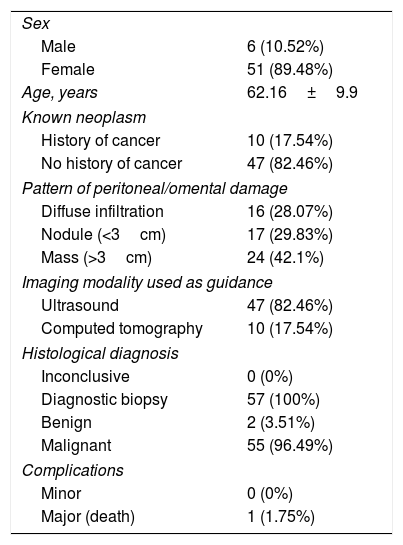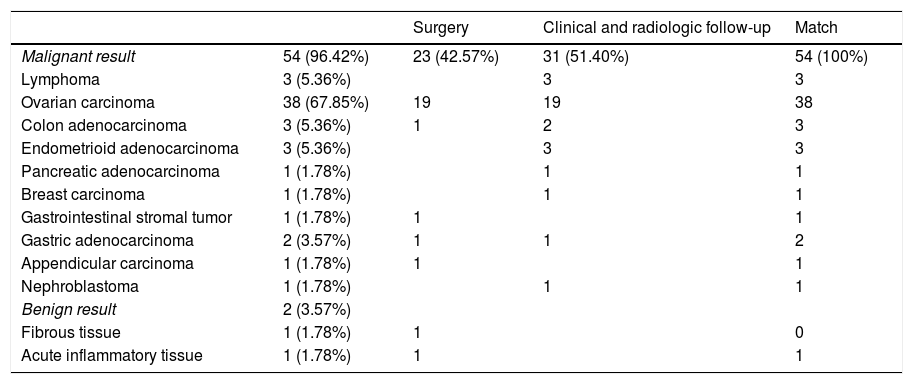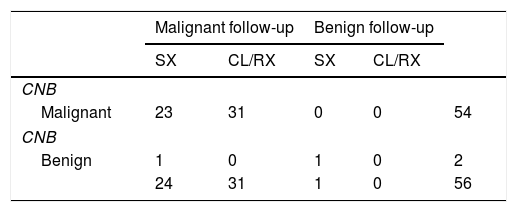To evaluate the diagnostic performance of imaging-guided core needle biopsy of nodules and diffuse infiltration of the omentum or of the peritoneum.
Materials and methodsWe retrospectively evaluated 57 patients who underwent core needle biopsy of the peritoneum or of the omentum between March 2014 and January 2017. We used computed tomography (CT) to plan the biopsy. Biopsies were guided by CT or ultrasonography (US). We classified the results as diagnostic (benign/malignant) or inconclusive (inadequate sample). We calculated the sensitivity, specificity, positive-predictive value, and negative predictive value. We analyzed whether the specimen was diagnostic depending on the imaging technique used (CT or US) and on the type of omental or peritoneal involvement from which the specimen was obtained (mass, nodule, or diffuse involvement).
ResultsAll (100%) the percutaneous biopsies were diagnostic. The sensitivity of the technique was 98.18% and the specificity was 100%. The positive predictive value was 100% and the negative predictive value was 50%. Both the specimens obtained under CT guidance (n=10) and those obtained under US guidance (n=47) were diagnostic. Likewise, biopsies of masses (n=24), of nodules (n=17), and even of diffuse infiltration (n=16) of the peritoneum or omentum enabled the histologic diagnosis. The rate of complications was 1.75% (one death).
ConclusionPercutaneous core needle biopsy has high sensitivity regardless of the imaging technique used to guide the technique (CT or US) and of the type of lesion biopsied (mass, nodule, diffuse infiltration). It is a useful technique with a very low rate of complications, although severe complications can occur.
Evaluar la rentabilidad de la biopsia percutánea con aguja gruesa guiada por técnicas de imagen de nódulos e infiltración difusa del omento o del peritoneo.
Material y métodosSe evalúan retrospectivamente 57 pacientes a los que se realizó una biopsia con aguja gruesa del peritoneo o del omento entre marzo de 2014 y enero de 2017. La tomografía computarizada (TC) al diagnóstico se empleó para planificar la biopsia. Los resultados se clasificaron en diagnósticos (benignos/malignos) o no concluyentes (muestra insuficiente). Se calcularon la sensibilidad, la especificidad y el valor predictivo positivo y negativo. Se analizó si la muestra fue diagnóstica según la técnica de imagen empleada (TC o ecografía) y el tipo de afectación del omento-peritoneo biopsiada (masa, nódulo o infiltración difusa).
ResultadosEl 100% de las biopsias percutáneas fueron diagnósticas. La sensibilidad de la técnica fue del 98,18% y la especificidad fue del 100%. El valor predictivo positivo fue del 100% y el negativo fue del 50%. Tanto las muestras obtenidas con guía por TC (10) como las guiadas por ecografía (47) fueron diagnósticas. Así mismo, las biopsias de masas (24), nódulos (17) e incluso de infiltración difusa (16) del peritoneo-omento permitieron el diagnóstico histológico. La tasa de complicaciones fue del 1,75% (una muerte).
ConclusiónLa biopsia percutánea con aguja gruesa es una técnica con una alta sensibilidad independientemente de la técnica de imagen empleada como guía de la punción (TC o ecografía) y del tipo de lesión biopsiada (masa, nódulo o infiltración difusa). Es una técnica útil con escasa tasa de complicaciones, aunque a veces pueden ser graves.













